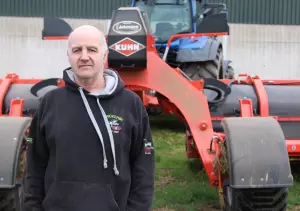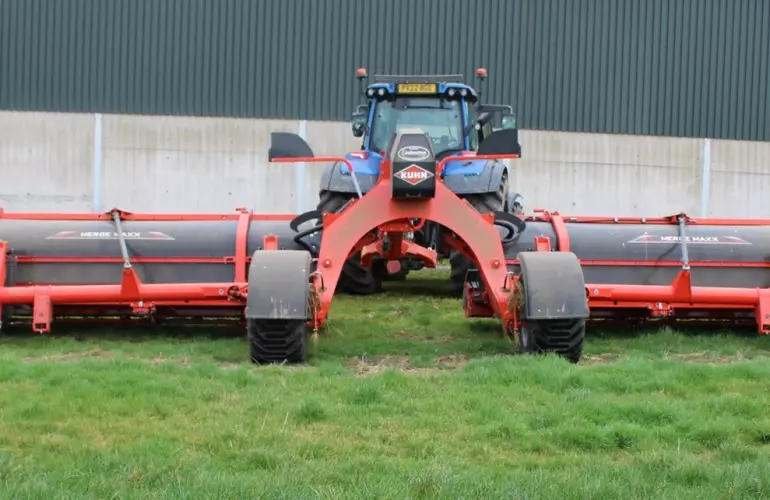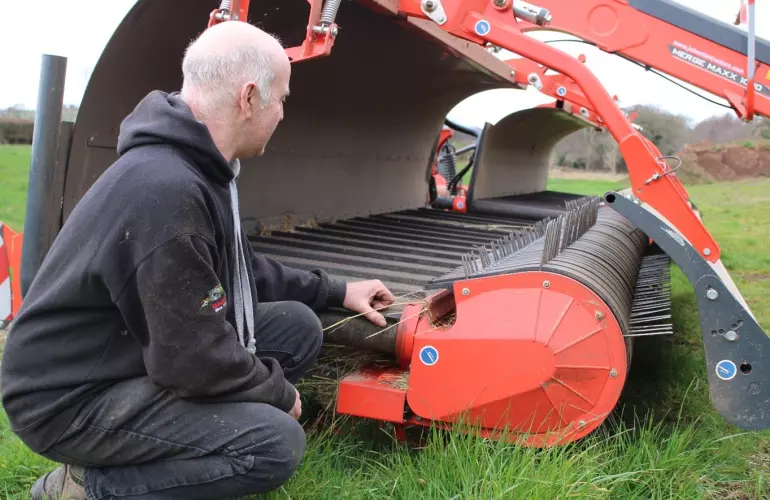Mixed farming enterprise puts forage first
Floshes Farms Ltd manages 16,000 acres of multi-cut system grassland each year. Brothers Stuart and Melvin Nelson farm 770 acres in partnership and contract to beef and dairy farms in Cumbria and the northwest. The brothers have developed an intricate and efficient mixed farming system that includes sheep, cattle, arable and a wide variety of machinery.

Following foot and mouth, the family decided not to go back into dairying. Instead they invested in beef cattle, growing the business to finish 1,400 head. However, this was not a sustainable model for the farm and the herd was sold to invest in a neighbouring farm.
“We bought the second farm so that we could set up the system we have today. It includes 200 acres of grass for silage and 570 acres for winter wheat, winter barley and spring barley. We use our buildings to overwinter 500 dairy heifers and 400 stores, on contract, which produce the muck and slurry we need to spread on our grassland. We also sow winter barley stubbles with stubble turnips and graze 2,500 fat lambs over winter for local farms,” explains Stuart.
The contracting business runs alongside this to make best use of the ever-increasing variety of machinery needed. Contract work starts with slurry application, fertiliser application and ploughing before the brothers and their team move on to silage and harvest work.
“We cut 16,000 acres of grass, 700 acres of wholecrop, 500 acres of maize and combine 1,500 acres of cereals, including our own land. This brings us to autumn cultivation work which starts the process again and sees us take on fresh livestock over winter,” he says.
This intricate system has been devised to minimise downtime and optimise every man and machinery hour available. It also offers efficiencies for the farm, with slurry being provided by overwintering livestock, and land on rotation being used to graze sheep. However, the focus is always the green harvest and with it comes the challenge of operating in increasingly unpredictable weather windows.
“We cut every 35 days for some farms, which keeps us busy from April to October. The challenge is finding machinery to work with wet grass and very dry straw. The weather has changed significantly, with summers much drier than previous years and springs often very wet.”
The business invested in a MergeMaxx 950 which ran for two years and demonstrated how the technology was superior to the two rotor rakes which preceded it. However, in the summer of 2022 this was traded for the larger 1090 which Stuart says covers a similar area to a 4-rotor rake.
“I can travel at 15 km/h with a forager following 90 minutes behind and it won’t catch me up until the end of the day. The MergeMaxx presents the grass so well for foragers. It is fluffier and doesn’t pick up stones like a rake, which helps the knives on the forager last longer. It also saves fuel because the knives stay sharper.”

He suggests that customers are requesting the MergeMaxx because it is more suited to the sticky grass that is common in multi-cut systems.
“Multi-cut grass is high in sugar and this makes it sticky when the dew burns off. I have had it ball up around the tractor wheels and stick to the tines of the rake. However, the MergeMaxx counteracts the sticky properties of the grass and can condition it perfectly for a baler or forager.”
Applying slurry in the drier conditions experienced in recent years has also raised concern with his customers, who do not want the quality of their bales or clamps to suffer from contaminants.
“Customers are concerned that a rake will pick up dirt and remnants of slurry that haven’t been washed off because we have so little rain during periods in the summer.”
He suggests tedders leave a lumpy swath that a rake will only compound, placing one lump on top of another. This makes it more difficult for balers to pick up and is less than ideal for foragers too.
“Customers are asking for chopped grass at as little as 6mm, so presenting the grass perfectly for the baler or forager is crucial. The MergeMaxx leaves a much better row for a baler.”

The MergeMaxx has banks of tines on a rotating reel that glide over the surface rather than contact it. This prevents soil from molehills or bare ground being incorporated into the grass. Adjustable, sprung skids under the machine ensure the tines are kept at a set height above the soil surface.
Forage is lifted by the tines on to a hydraulically driven, rubber conveyor. The gentle action helps to preserve the leaf area and, with it, the nutritional value of the crop.
“The aim is to produce the most nutritious forage for livestock, and the process of rowing up the grass, without damaging it or incorporating stones and contaminants, is crucial.”
Behind the pick-up reel, the conveyor has eight separate settings that can move the crop in either direction, allowing the size and number of swaths to be controlled. Stuart has used this to establish a method that works for when the grass is longer and wetter.
“The merger doesn’t like long wet grass, so we cut half rows by putting both beds together so both conveyors are pushing grass outwards, one to the left and one to the right. By driving in the gap and repeating the process we create two full rows, and we don’t suffer any blockages or downtime.”
In addition to the green harvest, the MergeMaxx doubles up as a straw rowing machine. Stuart splits the rows by running the conveyors in the same direction so that one makes a row in the middle of the machine and the other is working to one side.
The MergeMaxx is able to achieve this variety and speed of work whilst coupled to a relatively small tractor. Stuart uses a Valtra T154 which easily copes on a variety of land.
“It means we can keep fuel consumption down whilst not jeopardising operator comfort or safety. I can’t see any drawbacks of using the MergeMaxx for the work we do. It is faster and presents a crop with fewer impurities that is easier to bale or harvest, and all at 15 km/h," he concludes.
